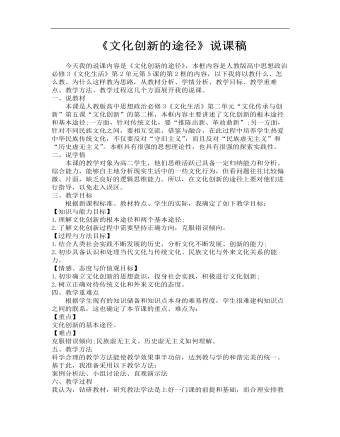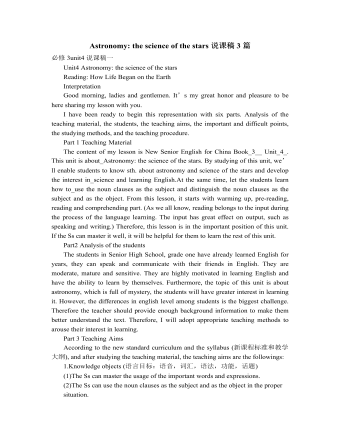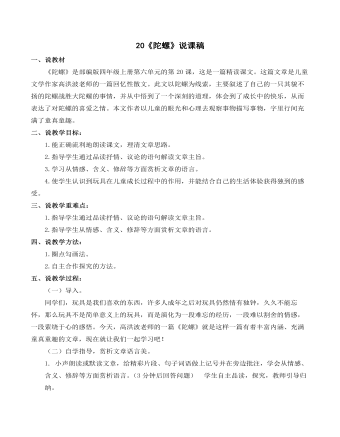人教版高中英语必修1Journey Down the Mekong说课稿
-
- 页数:4页
- 字数:约 8108 字
- 大小:37.65KB
- 格式:.docx
- 版本:Office2016及以上版本
- 作者:梁小A-PPT
Journey Down the Mekong说课稿
Good morning, ladies and gentlemen. Im greatly honoredto have the opportunity to share my teaching ideas with you. Today my topic is“Journey down the Mekong” taken from unit 3,book 1. My presentation consists of4 parts, They are : Analysis of the teachingmaterial, Teaching methods and learning methods, Teaching procedure andBlackboard design.

Part 1. Analysis of the teaching material.(说教材)
This part consists of 4 aspects
1. Status andfunction of this passage
This reading passage is the highlight of this unit. Itmainly talks about Wang Kun and his sister’s dream of taking a great bike tripdown the Mekong River, their preparation for the trip and some more details ofthe Mekong River. By studying of this unit, students will know how to make planand preparation for a trip. So it not only contains the most important wordsand sentence structures of this unit but also embodies the theme of this wholeunit.
(Now let’s come to the teaching aims, they are knowledgeaims, ability aims and emotional aims. )
2. Teaching aims.
(1) Knowledge aims:to help Ss master the new words and useful expressionsand learn to express future by present progressive tense
(2) Ability aims: to developSs’ reading skills, such as skimming, scanning and the ability of readingbetween lines. to let Ss use what they have learned to describe a trip.
(3)Emotional aims: to simulateSs’ love for nature and environment. to cultivate Ss’ internationalconsciousness.
(That’s all for the teaching aims, now let’s come to theteaching important and difficult points.)
3. The important and difficult points:
The important point is to help Ss to master new words andexpression. The difficult point is to help Ss to develop different readingskills and reading strategies.
4. Analysis of the students(说学生)
My students are first-grade students of senior highschool. They have been learning English in junior high school and haveaccumulated a certain number of vocabularies. They have mastered some simple learningstrategies and skills with a preliminary ability of speaking and writing.However, the differences in students personality and English proficiency arevery large. So my teaching design should have gradient to meet the need ofdifferent student. Travel is an interesting topic. I will seize the studentspsychological characteristics and stimulate students interest, so that they willlearn to participate in the study, and learn to study in the participation.
(That’s all for the first part,now let’s move to the second part.)
Part2. Teaching methods and learning methods(说教法&学法)
In order to finish the teaching aims above, I’ll mainlyuse “Task-based Language Teaching method”, “Communicative Teaching method”. Tomake the class a student-centered one, the students are encouraged to work ingroups and learn cooperatively, so they have more opportunities to practice. Teacheracts as an organizer, a listener and a helper.
And teaching aids are multi-media computer, tape-recorderand blackboard.
Part3. Teaching procedures.(说教程)
Now, let’s come to the most important part, the teachingprocedure. It includes 6 steps: Step I: Lead-in,Step II: pre-reading, Step III: While-reading, Step IV: Consolidation, Step V:Post-reading, StepⅥ: Homework.
Step I: Lead-in (3mins)
When we learn this lesson, the students just came back fromthe National Day not long before. I will take advantage of this opportunity tolet the students share their travel experience in class. So they will enjoy thefun of traveling. And then I will introduce the topic of this lesson to the Ss:how to make plan and preparation for a travel.
Purpose:Let theSs talk about their travel experience will greatly stimulate their interest inparticipating in the class.
Step II : pre-reading(4 mins)
1. T: Q1: Have you visitedany river? Q2: How many great rivers doyou know?
Q3 : If you could traveldown only one of them, which one would you choose? Why?
Show the Ss some picturesof rivers, ask the Ss to guess the names of these rivers.
2. T: Have you visited theMekong River? If no, let’s learn something about it. Show the Ss the picture ofMekong and ask them to list the countries the Mekong River flows through. Then Iwill introduce some background information of Mekong to the students. Such usthe Chinese part of the river is called the Lancang river.
Purpose: to arouse the Ssinterest in learning. Improve the SS language expressing ability.
Step III:While-reading (21mins)
(While-reading is the main part and it will takes 21 mins. This step isdivided into 3 parts.)
1) Review new words
Considering that thenew words may affect the understanding of the text, so I will review the newwords to the SS first, such us: ever since, persuaded, cycling, graduating,finally, schedule, fond of , shortcoming, stubborn, organize.
2)Fast reading:skimming &scanning
During fastreading, I will ask the Ss to reading the whole passage quickly and get themain idea of each paragraph.
Para1: Deciding totake a great bike trip along the Mekong river.
Para2: Differentattitudes between Wang Kun and Wang Wei.
Para3: Thepreparation before the trip and details about Mekong river.
Purpose: to trainSs’ reading ability, such as skimming and scanning. And help the Ss understandthe general idea of the text.
3) Careful reading: intensive reading
Let the students read the passage again and do a T or Fexercise. And if it is F, I will ask them to correct it. In this step, I’m going to divide the Ss into fourgroups, and let them have a competition. The one who stand up fast and give theright answer can get ten marks for his group, the group which gets the highestmark will get a present.
This exercise canhelp the Ss get the key information of the passage in a short time and candeepen the Ss’ understanding of the text.
Step IV :Consolidation (6mins)
1. Play the tape of the passage forthe students to listen and then ask them to read it aloud. Tell them to payattention to the pronunciation, stress and intonation while listening. At thesame time they can enjoy the beauty of English language. And it can prepare theSs for the retelling in next step.
Purpose here is to improve Ss’ ability to grasp the mainideas when listening.
2. let the Ss complete the formsparagraph by paragraph.
Purpose here is to help Ss to get the habit of reading apassage as a whole, and pay attention to the organization of the text, as aresult the Ss will fully understand the whole passage.
您可能喜欢的文档
查看更多
高中思想政治人教版必修三《文化创新的途径》说课稿
- 页数:4页
- |大小:33.63KB

人教版高中英语必修3Astronomy the science of the stars说课稿3篇
- 页数:10页
- |大小:96.50KB

人教版高中英语必修1English around the world说课稿
- 页数:7页
- |大小:56.89KB

高中思想政治人教版必修一《收入分配与社会公平》说课稿
- 页数:6页
- |大小:49.51KB

人教版高中英语必修2The Band That Wasn’t说课稿3篇
- 页数:8页
- |大小:194.50KB

人教版高中英语必修2The Olympic Games说课稿2篇
- 页数:6页
- |大小:137.00KB

人教版高中英语必修3Festivals around the World说课稿3篇
- 页数:8页
- |大小:81.00KB
热门说课稿

小班生活《小脚找朋友》说课稿
- 页数:2页
- |大小:33.31KB
- 说课稿

幼儿园大班说课稿 动物怎样过冬
- 页数:3页
- |大小:36.00KB
- 说课稿

小学数学人教版一年级上册《认识钟表》说课稿
- 页数:4页
- |大小:24.27KB
- 说课稿

中班健康《袋鼠跳》说课稿
- 页数:2页
- |大小:34.88KB
- 说课稿

幼儿园中班课后说课稿 雪花和雨滴
- 页数:3页
- |大小:37.00KB
- 说课稿

《陀螺》说课稿
- 页数:4页
- |大小:39.00KB
- 说课稿
今日更新

5月份主题教育工作情况总结汇报
- 页数:3页
- |大小:136.87KB

××县招商局2024年上半年工作总结
- 页数:12页
- |大小:142.54KB

×××公安局机关党委上半年党建工作总结
- 页数:7页
- |大小:186.25KB

《2019—2024年全国党政领导班子建设规划纲要》实施情况的工作总结3800字
- 页数:6页
- |大小:29.16KB

“转观念、勇担当、新征程、创一流”主题教育活动阶段性工作总结
- 页数:3页
- |大小:22.76KB

“四零”承诺服务创建工作总结
- 页数:5页
- |大小:39.83KB





